How Does Architecture Incorporate Principles Of Adaptive Reuse?
 Have you ever walked by an old building and wondered why it's not being used? What about one that has been repurposed for a new business or residence? That's what adaptive reuse is all about. In essence, it's the process of taking an existing structure and converting it into something else.
Have you ever walked by an old building and wondered why it's not being used? What about one that has been repurposed for a new business or residence? That's what adaptive reuse is all about. In essence, it's the process of taking an existing structure and converting it into something else.
Many buildings have a long history, and adaptive reuse helps breathe new life into them, saving them from demolition or abandonment. This practice is beneficial in numerous ways and has become increasingly popular in recent years.
How Adaptive Reuse Extends the Lifespan of A Building
Adaptive reuse is not a new concept. In fact, it's been around for centuries. However, as the world becomes more environmentally conscious, finding ways to reduce waste and preserve resources is critical. Adaptive reuse is one way to help conserve the planet while also benefiting our communities.
Here are just a few ways that adaptive reuse helps extend the lifespan of a building:
1. Preserves Historic Buildings
Many buildings have historical or cultural significance that is worth preserving. By repurposing these structures, their original character and value can be retained for future generations. It allows us to honor the past while also providing modern functionality.
2. Saves Energy
Repurposing existing buildings means less manufacturing of new materials and products, which reduces the amount of energy needed to create them. It also reduces the amount of waste that results from demolishing old buildings to erect new ones.
3. Reduces Land Use
Adaptive reuse eliminates the need to build on new land, reducing urban sprawl and preserving natural habitats. This helps to maintain the balance between human activity and the environment.
4. Creates Jobs
The renovation and repurposing of buildings create jobs in a variety of fields, including construction, design, and architecture. It can also bring new businesses and opportunities to communities that may have been struggling economically.
5. Saves Money
Repurposing a building is often less expensive than tearing it down and constructing something new. The existing structure provides the foundation, eliminating the need for extensive excavation and foundation work. It also helps to mitigate costs associated with waste disposal fees, transportation of debris, and landfill usage.
6. Increases Property Value
Adaptive reuse can also increase the value of a property. Buildings with a unique history or notable design attributes can add character to a neighborhood or community. They can also be repurposed for commercial or residential use to meet the needs of the current market demand.
7. Encourages Creativity
The process of adapting an existing building into something new requires creativity and innovation. It challenges designers and architects to think outside the box and find creative solutions. This encourages new ideas and design concepts, resulting in a more vibrant and diverse built environment.
FAQ (Frequently Asked Questions)
Q: What types of buildings are good candidates for adaptive reuse?
A: Many kinds of buildings can be repurposed, including old factories, warehouses, and schools that may no longer be in use. Churches, museums, and theaters can also be renovated and converted for new purposes.
Q: Are there any downsides to adaptive reuse?
A: One challenge is that older buildings may not meet modern safety or accessibility standards. This means that additional work may need to be done to bring them up to code. However, many of these issues can be addressed with careful planning and design.
Q: What kind of businesses or residences can be created with adaptive reuse?
A: The possibilities are endless. Adaptive reuse can create spaces for residential, commercial, educational, and cultural uses. They can be transformed into apartments, offices, restaurants, art galleries, and more.
Q: How can I learn more about adaptive reuse in my area?
A: Research local history organizations, preservation societies, and city planning offices. They may be able to provide information about buildings and spaces that have already been repurposed or identify opportunities for future adaptive reuse projects.
Conclusion
Adaptive reuse is more than just a trendy way to repurpose old buildings. It's a practical and sustainable method that benefits our planet and our communities. By preserving history, reducing waste, creating jobs, and fostering creativity, adaptive reuse helps build vibrant and thriving cities and towns.



Post a Comment for "How Does Architecture Incorporate Principles Of Adaptive Reuse?"